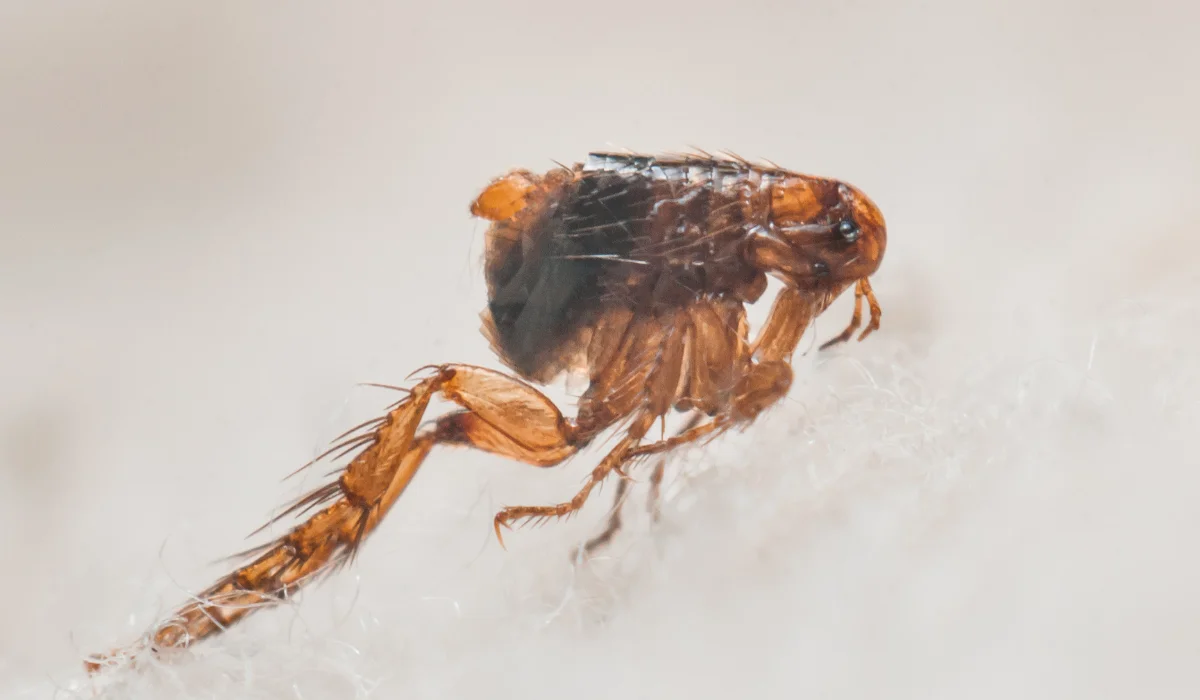No one expects to deal with fleas until it becomes a problem too big to ignore. You notice your dog scratching more than usual, or your cat suddenly refusing to sit on their favorite bed. Maybe you wake up with strange bites around your ankles. These moments raise one big question: what do fleas look like and how do you know if that’s what you’re dealing with? Identifying fleas early can prevent weeks or months of discomfort—for both pets and people. This guide is built not just to show you what fleas look like in every stage, but to help you read the signs, understand what to look for, and act before it turns into an infestation.
Understanding Fleas and Their Life Cycle
Fleas are small, wingless insects that survive by feeding on the blood of animals. Most household infestations involve the cat flea (Ctenocephalides felis), which affects both cats and dogs, and sometimes humans. These parasites are resilient, silent, and fast. They often stay hidden until they’ve established a full presence in your environment.
A flea’s life cycle includes four stages: egg, larva, pupa, and adult. This complete transformation allows them to spread quietly. Eggs are laid on the host but fall off quickly, landing in carpets, cracks in the floor, or pet bedding. Larvae hatch and feed on organic matter like dried blood, known as flea dirt. They spin cocoons and enter the pupal stage, where they can stay dormant for weeks or even months until the right conditions trigger emergence. Adults emerge when they sense vibration, heat, or carbon dioxide—signals that a host is nearby.
This cycle explains why infestations are hard to spot early. You may only notice adult fleas, but by then, the other stages are already hidden in your home.
Physical Appearance of Fleas
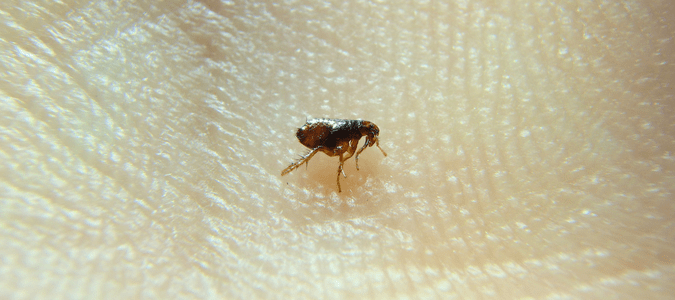
Size and Shape
Adult fleas are 1.5 to 3.3 millimeters long. That’s roughly the size of a sesame seed, which makes them hard to notice at first glance. Their bodies are flat from side to side, a shape that helps them slip through fur or feathers and hide near the skin of the host.
If you manage to catch one between your fingers or with a flea comb, you’ll notice their compact, narrow build. They are also covered with tiny spines that point backward, which help them grip onto hair and resist grooming.
Color and Texture
Fleas are usually reddish-brown or dark brown. After feeding, they may appear darker due to the blood inside their bodies. Their exoskeleton is smooth and glossy, which reflects light and helps them blend into dark fur or fabric.
They have a hard outer shell that’s surprisingly durable for such a small insect. Trying to crush one with your fingers doesn’t always work. This toughness, combined with their ability to hide, makes physical detection difficult without close inspection.
Legs and Movement (Jumping Ability)
Fleas don’t walk or fly. They jump. Their hind legs are long and powerful, enabling them to leap up to 33 centimeters in length and 18 centimeters in height. That’s more than 100 times their body size.
This jumping ability helps them move between hosts and escape threats quickly. It’s also the reason they are hard to catch. If you spot something small and fast moving from your pet’s fur or jumping onto your sock, it’s likely a flea.
Mouthparts and Feeding Behavior
Adult fleas feed on blood using piercing and sucking mouthparts. They bite into the skin and draw blood through a narrow feeding tube. Before feeding, they inject saliva containing anticoagulants to prevent the blood from clotting. This saliva often causes itching and skin irritation.
Pets can develop allergic reactions to flea saliva, known as flea allergy dermatitis, which leads to hair loss, redness, and intense scratching. A single flea can feed multiple times a day, and female fleas need a constant blood supply to produce eggs—up to 50 per day under ideal conditions.
What Flea Eggs, Larvae, and Pupae Look Like
Flea Eggs
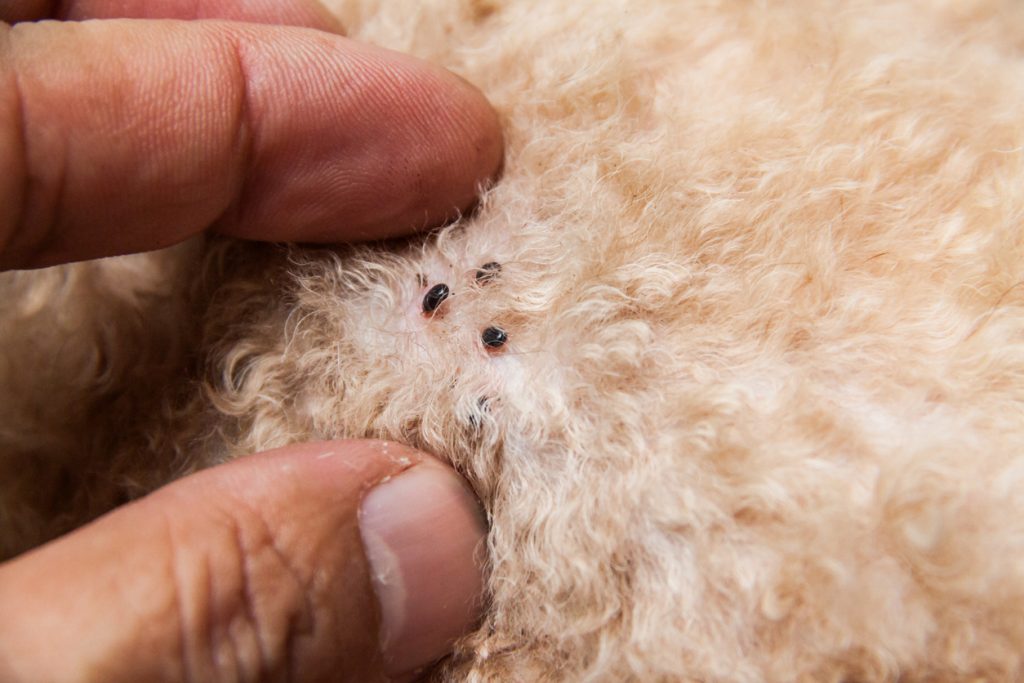
Flea eggs are tiny, about 0.5 millimeters, and white or off-white in color. They are oval-shaped and look like small grains of salt. You won’t see them stuck to your pet’s fur. Instead, they fall off easily and collect in your home’s soft surfaces.
They tend to gather in places your pet sleeps or rests—blankets, carpets, rugs, or floor cracks. Eggs hatch within two to twelve days, depending on humidity and temperature. High humidity and warmth speed up this process.
Flea Larvae

Once hatched, flea larvae look like tiny white worms with no legs. They grow up to 5 millimeters long and move away from light. You will rarely see them unless you’re looking deep in carpets, under furniture, or inside cracks.
They feed on organic debris, especially flea dirt, which is actually adult flea feces containing dried blood. This is why larvae tend to stay close to where pets rest—they follow the trail of food. Larvae stay in this stage for 5 to 11 days before spinning cocoons.
Flea Pupae (Cocoon Stage)
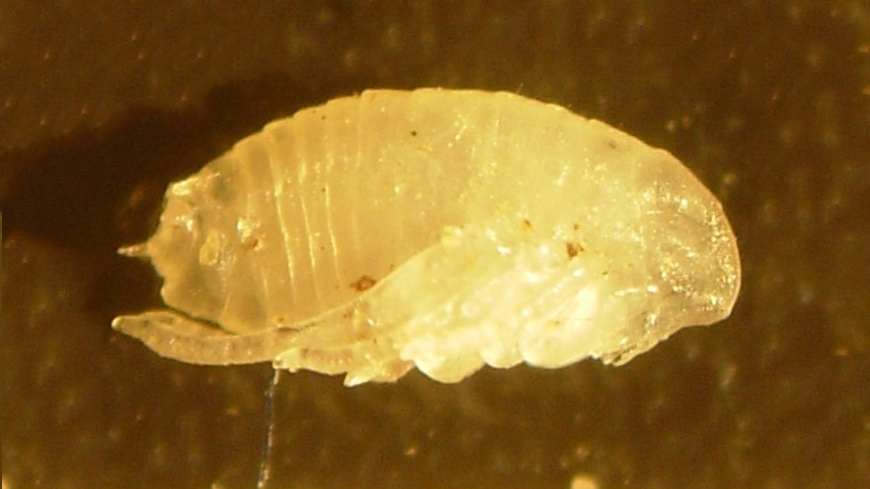
The pupal stage is the most hidden and protected. Larvae spin silk cocoons that attract dust and debris, making them nearly invisible in the environment. They measure about 4 millimeters and are sticky to the touch.
Inside the cocoon, fleas develop into adults. They can stay dormant for weeks or months until they detect movement or heat. This is why infestations often return even after you think they’re gone. Most home treatments miss this stage entirely unless you use insect growth regulators.
What Adult Fleas Look Like on Pets and Humans
Fleas on Dogs

Fleas on dogs often hide along the spine, near the tail base, and around the neck. These areas are harder for dogs to groom. Fleas move quickly through fur, making them hard to spot without a fine-tooth comb.
You may notice dark specks on the skin. These could be flea dirt. If you place them on a wet tissue and they turn red, it’s dried blood. Dogs often show signs of discomfort through chewing, licking, or restless behavior.
Fleas on Cats
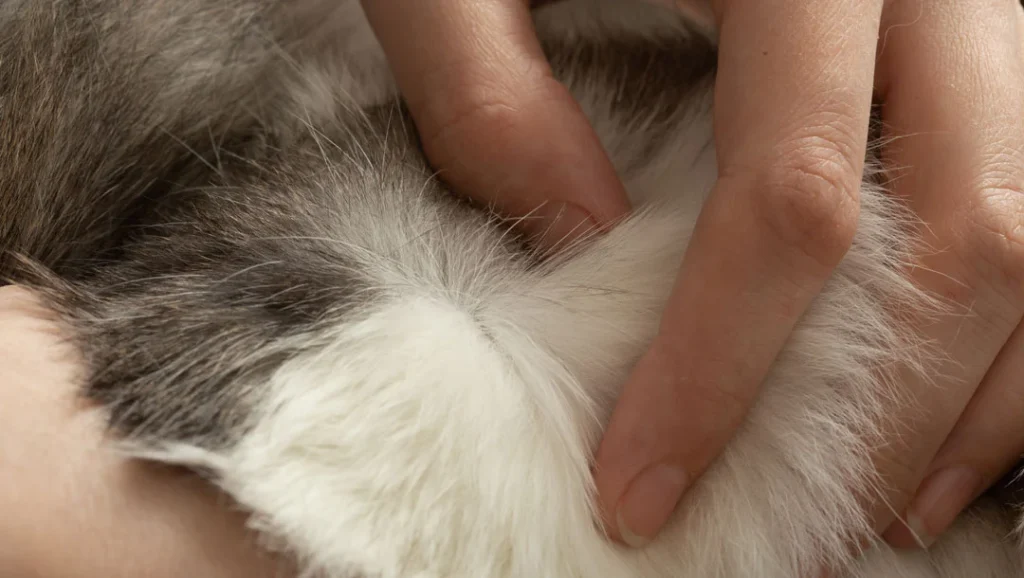
Cats are excellent groomers, which makes flea detection more difficult. Fleas tend to hide around the head, neck, and belly—areas cats have trouble reaching. You might not see live fleas, but you’ll notice excessive scratching or bald patches.
Even one or two fleas can trigger allergic reactions in sensitive cats. Use a flea comb and focus on hidden areas. Flea dirt is often easier to find than the fleas themselves.
Fleas on Humans (Rare but Possible)
Fleas do not live on humans, but they can bite. Bites usually occur on ankles, lower legs, or waistline. They appear as small red bumps, often in clusters, and are very itchy.
You may pick up fleas from carpets or pet bedding, especially after sitting on the floor. If you notice sudden itching or bites after spending time with pets or in infested areas, fleas are a likely cause.
Differences Between Fleas and Similar Pests
Fleas vs. Ticks
- Fleas are insects with six legs and a flat body from side to side.
- Ticks are arachnids with eight legs and a wider, flatter body from top to bottom.
Ticks attach firmly and feed for hours or days. Fleas bite and move quickly. Ticks are often found outdoors; fleas thrive both inside and outside.
Fleas vs. Bed Bugs
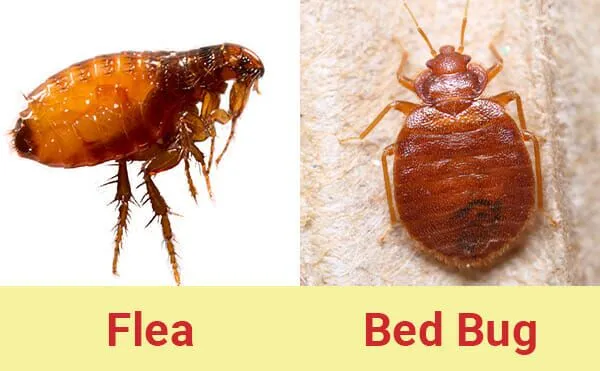
Bed bugs are about the same size as fleas but have a wider, oval shape and move slower. They don’t jump and usually come out at night to feed on humans.
Flea bites often appear on lower limbs. Bed bug bites usually show up on the arms, neck, or back. Bed bugs live in mattresses or cracks near beds. Fleas prefer to live on pets and in fabrics where pets rest.
Fleas vs. Lice
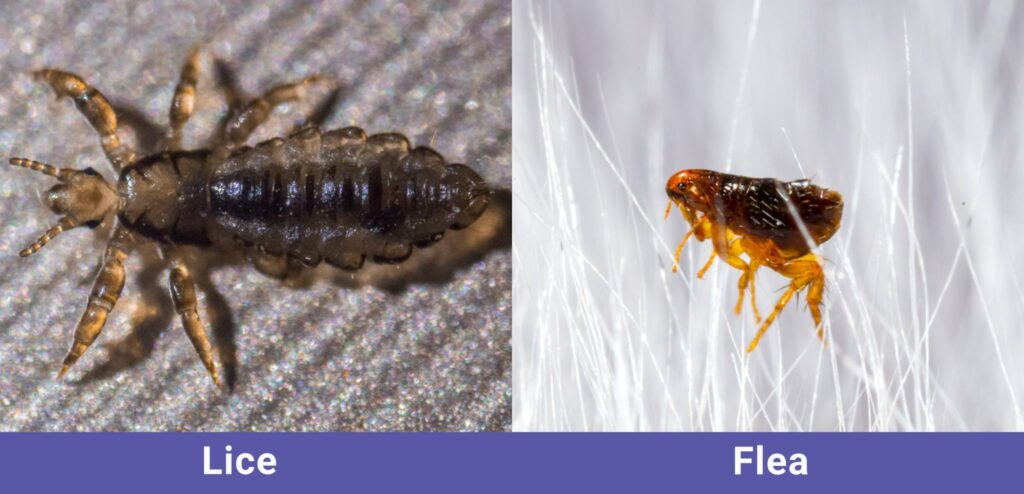
Lice are also wingless insects, but they stay on the host permanently. They move slowly and cannot jump. Lice infestations are more common in humans and are species-specific.
Fleas jump, bite multiple species, and spend time off the host. This makes environmental treatment essential when dealing with fleas, unlike lice.
How to Identify Fleas in Your Home
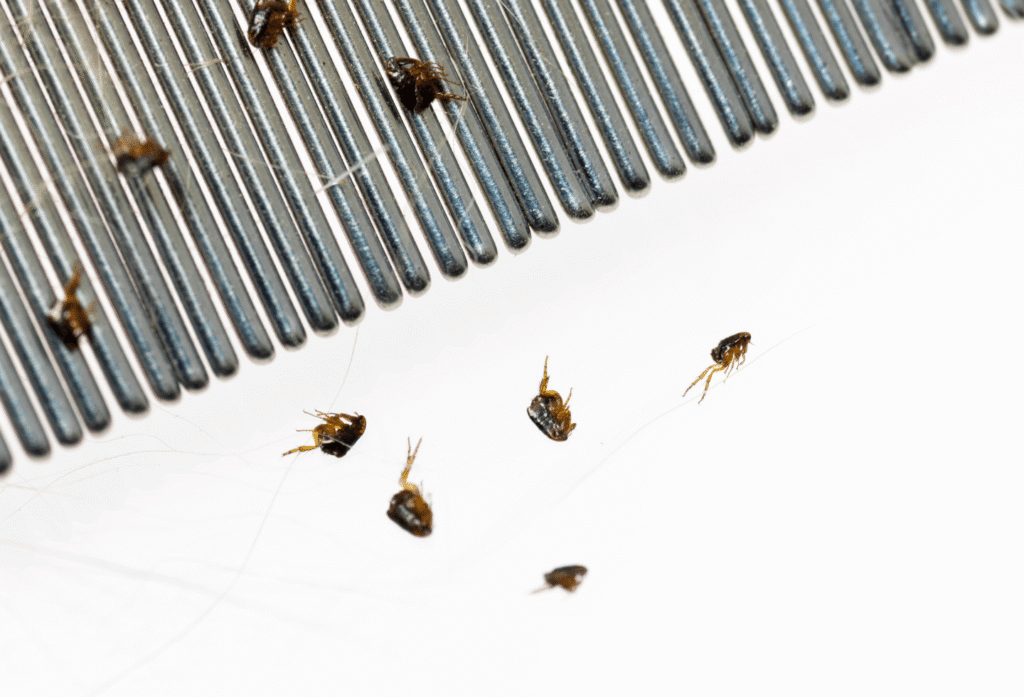
Signs of a Flea Infestation
You may not see fleas right away, but you’ll notice the effects. Watch for these:
- Pets scratching or biting themselves more than usual
- Small red bites on your ankles or legs
- Black specks (flea dirt) on pet skin or bedding
Also, check carpets, rugs, and corners of rooms where pets spend time. Infestations often start small and become noticeable only when adults emerge in greater numbers.
Using a Flea Comb or White Sock Test
The flea comb test is effective for checking pets. Comb slowly through the fur, especially near the tail and belly. Wipe the comb on a damp paper towel to check for red-stained debris.
The white sock test involves wearing white socks and walking across carpeted areas. If fleas jump onto your socks, they will stand out against the fabric. This is a simple, non-invasive detection method.
What Flea Dirt Looks Like (and How to Spot It)
Flea dirt is a major sign of infestation. It looks like black pepper but is actually flea feces. You’ll often find it in pet fur or bedding.
To test it, place the specks on a wet tissue. If they dissolve into a reddish stain, it’s digested blood. Flea dirt confirms that fleas are not just present—they’re actively feeding.
When to Seek Professional Pest Control Help
If you’ve tried cleaning, vacuuming, and over-the-counter treatments without success, it’s time to call a professional. This is especially important if:
- Fleas return shortly after treatment
- You see fleas in multiple rooms
- Your pets are still infested after medication
Professionals use insect growth regulators and targeted treatments that kill all life stages. They can also identify hidden sources of infestation and prevent recurrence.
Conclusion: How to Recognize and Act on Flea Sightings Early
Fleas don’t go away on their own. Waiting allows their numbers to grow, and the longer they stay, the harder they are to remove. Knowing what fleas look like at each stage of life helps you catch the problem early.
Use combs, inspect bedding, monitor bites, and pay attention to changes in your pet’s behavior. The moment you see signs, act. Clean thoroughly, treat pets immediately, and consider professional help if the problem spreads.
Early action means less discomfort, less cost, and a healthier environment for everyone in your home.
